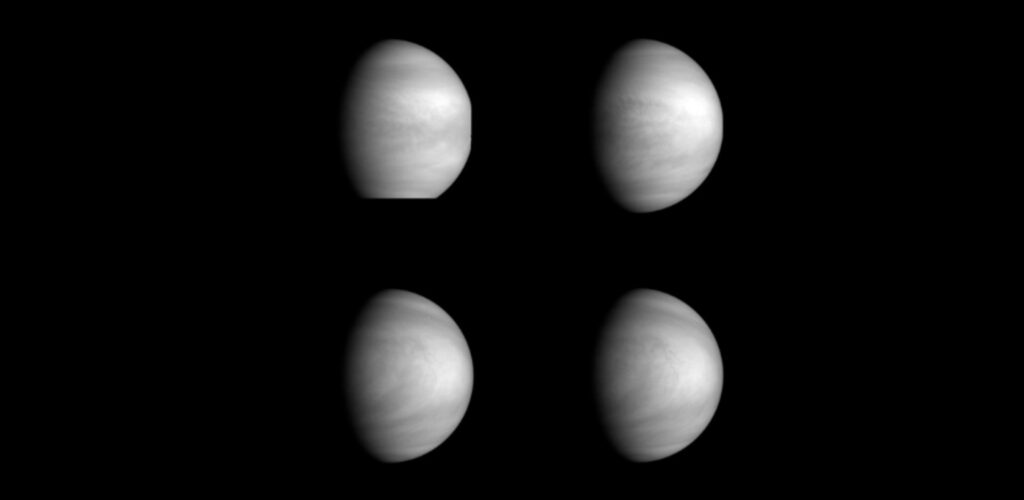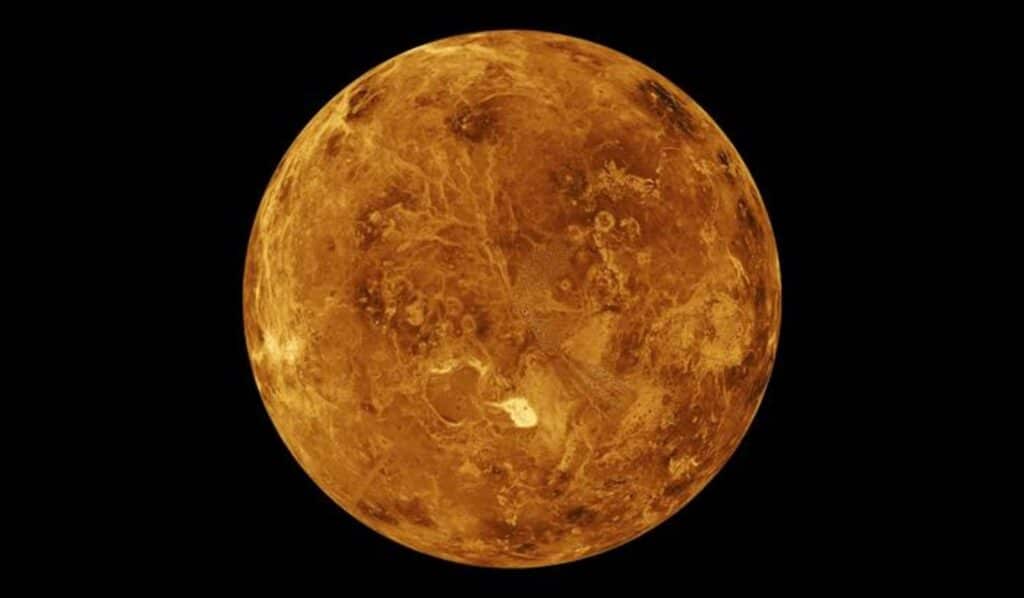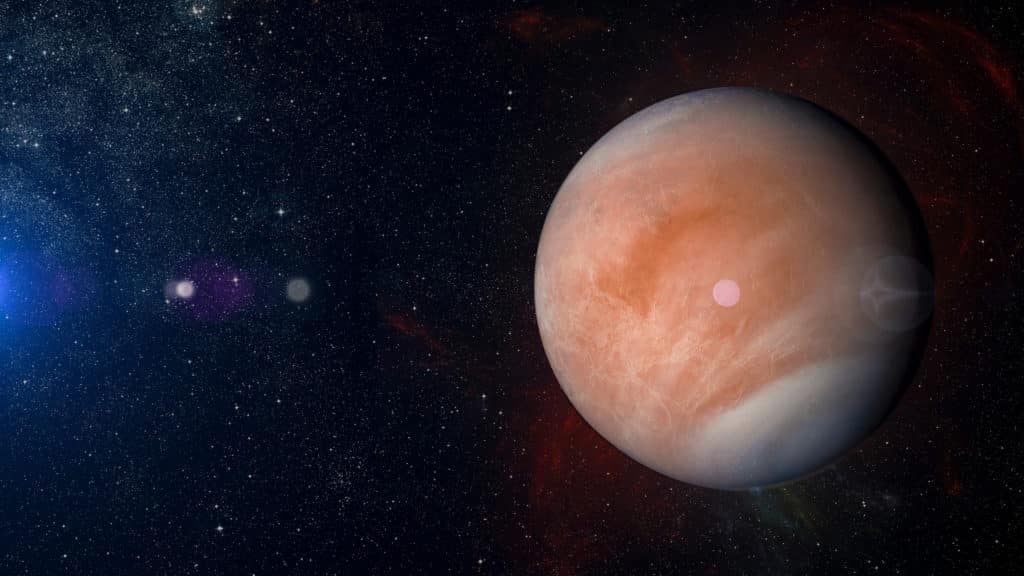The mystery surrounding the distinct colors and patchiness of Venus’ clouds has finally been solved. Scientists from the University of Cambridge have identified specific minerals that might be responsible for these unique features in the Venusian atmosphere, which are only visible in ultraviolet (UV) light.
For years, the composition of Venus’ clouds has puzzled scientists. It’s known that they are primarily composed of sulfuric acid droplets, with traces of water, chlorine, and iron, varying in concentration at different altitudes in the planet’s dense and hostile atmosphere. However, the exact cause of the clouds’ distinctive patches and streaks, observable only in the UV spectrum, has remained elusive.

The recent study offers an explanation. Cambridge scientists synthesized iron-bearing sulfate minerals that can withstand the harsh chemical conditions of Venus’ clouds. Through spectroscopic analysis, they discovered that a combination of two minerals, rhomboclase and acid ferric sulfate, could account for the peculiar UV absorption feature observed on Venus.
“The only available data for the composition of the clouds were collected by probes and revealed strange properties of the clouds that so far we have been unable to fully explain,” says study co-author Paul Rimmer, from the Cavendish Laboratory at the University of Cambridge, in a media release. “In particular, when examined under UV light, the Venusian clouds featured a specific UV absorption pattern. What elements, compounds, or minerals are responsible for such observation?”
Researchers conducted experiments in an aqueous geochemistry laboratory, creating several iron-bearing sulfate minerals. They then suspended these minerals in sulfuric acid at varying concentrations, monitoring the chemical and mineralogical changes. This process led them to pinpoint rhomboclase and acid ferric sulfate as the likely culprits, whose spectroscopic features were then examined under light sources mimicking the spectrum of solar flares.
A collaborative effort with a photochemistry lab at Harvard University provided additional insights. The Harvard team measured the UV absorbance patterns of ferric iron under extremely acidic conditions, aiming to replicate the more extreme environment of Venus’ clouds. This collaborative research is part of the newly established Origins Federation, which promotes such interdisciplinary scientific endeavors.
“The patterns and level of absorption shown by the combination of these two mineral phases are consistent with the dark UV-patches observed in Venusian clouds,” says study co-author Clancy Zhijian Jiang, from the Department of Earth Sciences at the University of Cambridge. “These targeted experiments revealed the intricate chemical network within the atmosphere, and shed light on the elemental cycling on the Venusian surface.”

Rimmer reflected on the importance of understanding the enigmatic Venus.
“Venus is our nearest neighbor, but it remains a mystery,” concludes Rimmer. “We will have a chance to learn much more about this planet in the coming years with future NASA and ESA (European Space Agency) missions set to explore its atmosphere, clouds and surface. This study prepares the grounds for these future explorations.”
The research, supported by the Simons Foundation and the Origins Federation, marks a significant step forward in deciphering the enigmatic features of Venus’ atmosphere, potentially unlocking new understanding of our neighboring planet.
The study is published in the journal Science Advances.
Exploring the Possibility of Life on Venus
Venus, often referred to as Earth’s “sister planet” due to its similar size and proximity, has long intrigued scientists and space enthusiasts alike. The question of whether life could exist on Venus, given its extreme conditions, remains one of the most fascinating queries in planetary science.
The Hostile Environment of Venus
- Surface Conditions: Venus boasts a surface temperature of around 462°C (864°F), hotter than Mercury’s, despite being farther from the Sun. This intense heat is enough to melt lead and is attributed to a runaway greenhouse effect.
- Atmospheric Composition: The planet’s thick atmosphere is composed primarily of carbon dioxide, with clouds of sulfuric acid, creating a highly acidic environment.
- Pressure: The surface pressure on Venus is about 92 times that of Earth, equivalent to the pressure found 900 meters (3,000 feet) underwater on Earth.
Given these harsh conditions, the prospect of life as we know it surviving on the Venusian surface seems improbable. However, the focus of potential life on Venus shifts when we look upwards, towards its clouds.
The Clouds of Venus: A Haven for Life?
- Mild Temperatures and Pressure: About 50 to 60 kilometers above the surface, the conditions in Venus’ clouds are more temperate, with temperatures and pressures close to those on Earth’s surface.
- Discovery of Phosphine: In 2020, researchers detected phosphine, a gas often associated with life, in Venus’ atmosphere. While the presence of phosphine doesn’t confirm life, it raises questions about unknown chemical processes on Venus.
- Acidic Cloud Droplets: The clouds of Venus are acidic, which poses a challenge for life. However, some extremophiles on Earth thrive in acidic environments, suggesting that life, if present, could have adapted to similar conditions on Venus.
Scientific Missions and Future Exploration
- Several missions are planned to explore Venus in the coming years. These include NASA’s VERITAS and DAVINCI+ missions, and ESA’s EnVision mission, all aiming to study Venus’ atmosphere and geological features.
- Understanding Venus’ atmosphere, particularly the composition of its clouds, could provide insights into the possibility of microbial life.
A Cautionary Note
- The search for life on Venus is in its infancy, and the detection of life indicators like phosphine is not definitive proof of life. These findings open the door to more questions and require further investigation.
The question of life on Venus is a tantalizing one, capturing the imagination of many. While the surface of Venus seems inhospitable, the planet’s clouds offer a more promising environment for the potential of life, albeit likely microbial and vastly different from life on Earth. As we await the results from future missions, Venus remains a planet of mystery and potential, holding a unique place in our quest to understand life in the universe.












